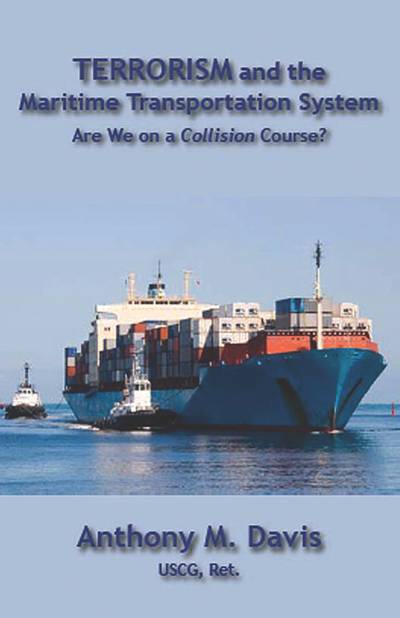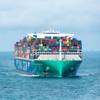Terrorism and the Maritime Transportation System
Understanding the maritime threat requires an historical review of criminal and terrorist elements. A closer look at the methodologies of terrorism gives greater insight to the maritime condition as it stands today. Some threats have remained for years, others are practiced daily in far away places; distant from the comfort we call our homeland.
"Terrorism and the Maritime Transportation System" will not pretend to provide answers to all of the threats we face - only provide greater magnification for understanding. Prevention comes by recognizing the possibilities and then developing sufficient contingency plans. Circumstances currently exist allowing the possibility of terrorist actions within our borders. Far too often, we allow these opportunities by living in denial, or, by yielding too much latitude to groups opposed to responsible societal control.
This book is written with the first responder in mind. If a maritime-related casualty occurs, the local police, fire and emergency management personnel will be tasked to the scene. This was proven true during the Minnesota Bridge collapse and will be replicated in the future. Because of training and funding shortfalls, the same professionals that we rely upon have little understanding of the maritime realm and the ramifications of addressing such a scene. Additionally, this book was written for the maritime professional with many years of service. There is such a thing as being too close to the subject to see the environment. "Terrorism and the Maritime Transportation System" presents a fresh look to help planners, operators and security managers as they consider contingencies.
When discussing maritime security, it is important to look far beyond maritime shipping. As a natural response, we think of ships and coastlines. The immense bodies of water surrounding our nation become mental barriers protecting us from foreign attack. The U.S. has over 95,000 miles of coastline and 361 official maritime ports of call. Our maritime interests include nearly 3.5 million square miles of Exclusive Economic Zone (EEZ). The land borders of Canada and Mexico additionally play a vital role in the Maritime Transportation System. We will look at the significance of these borders in respect to maritime security in the pages ahead.
The maritime industry is an intermodal transportation component vital to maintaining the economic welfare of the nation. The Maritime Transportation System includes over 25,000 miles of navigable waterways including the Great Lakes, St. Lawrence Seaway and over 3,700 marine terminals. Through 1,400 intermodal connections, the Maritime Transportation System links with over 174,000 miles of rail connecting 48 states, Canada and Mexico.
Our transportation system encompasses over 45,000 miles of interstate highways, supported by 115,000 miles of other roadways and 2.4 million miles of pipeline. Hundreds of maritime ports and the protection of federal navigational systems including locks and dams are part of the vital arteries making up the Maritime Transportation System.
Given the view of the Marine Transportation System noted above, the immense quantity of targets and locations exponentially multiply the potential for criminal or terrorist exploitation. As the broadened view of the Maritime Transportation System is covered, it may appear that the maritime focus is lost. These subtle shifts are intentional as it is important to show perspectives of criminals and terrorists, and show the potential vulnerabilities we face.
I expect that there will be those that disagree with some of my perspectives. Many academicians provide valuable insight to how particular terrorist groups operate and I respect that. This book comes from my experience, as a maritime investigator, and a prior maritime intelligence officer. The academic perspective provides a valuable baseline. My viewpoint from being on scene augments the maritime issue for better understanding. With that, it is important to note that having been within the intelligence realm, this book contains no classified information. All sources used comes from open source reporting and a variety of government sponsored reports.
This text is written in three sections. Beginning with Criminals, Terrorists and First Responder Challenges, we will see some of the many issues for both law enforcement and the intelligence community when an event occurs. Is the event the work of criminals or terrorists? Is there a potential for a secondary attack? If so, what actions are needed? How and when can evidence be collected? You will see that the definition of terrorism is a nebulous thing. The definition changes according to who explains it. The FBI for instance has two characterizations depending upon the geographic location of the incident. I provide my own perspective and definition that merges criminal and terror events. I believe terrorism can be characterized according to who the target is and the intended outcome.
Given my definition, we will take a new look at historical crimes and discuss whether these could be classified as terrorism or not. If another terrorist attack occurs within our borders, citizens will have expectations of both the law enforcement and intelligence communities. Yet, we need to understand the challenges they face with training, developing collaborative networks and the many expectations placed upon them. I conducted a four-year survey dealing with this issue. The respondents, all of them being law enforcement, intelligence, security professionals or first responders, provided the same bleak picture of the challenges they face. In order to prevent a terror attack, we need to know what terrorism is and what our capabilities or shortfalls are. This first section covers many of those issues and I fully expect this area will encompass the most debate.
The second section, The Maritime Realm addresses the ships and the crew that sail them. We will look at the structural condition of ships over time and some indicators of ships operated by, or transporting criminal or terrorist elements. No one thought that terrorists would use aircraft as a deadly attack mechanism. We should not be so ignorant about the maritime realm. This section reviews maritime casualties and the inter-relation to terrorism. Even after the 9/11 attacks, some classes of vessels operate along our waterways with little or no oversight. This is purely the fault of lobbyists and politicians unwilling to pursue safe and secure legislation.
We will see how small vessels can become highly efficient tools of terror on the water. As we address maritime piracy, the question once again returns of where the line is drawn between criminal and terrorist activity. We will then address Liquefied Natural Gas (LNG) ships. The press and some politically focused groups have characterized these vessels as floating bombs. There are dangers associated with these vessels, but it is vital to debunk the myths and share the facts so that first responders will know the proper actions to take in the event of an incident.
The final section, Other Issues of Concern discusses a bacterial and non-indigenous alien species invasion that our nation faces everyday from incoming ships. The result of these daily attacks costs our national economy billions of dollars each year in damage and control costs. The environmental and economic impact eventually brought President Clinton to draft an Executive Order to address the issue. The final portion of this section will talk about national transportation infrastructure and our vulnerabilities from within our borders as well as external elements targeting us. As the reader, you will benefit by considering the intermodal nature of cargo from the ship to the consumer and how criminal and terror incidents abroad could be effectuated here. What areas within the Maritime Transportation System remain vulnerable? How can law enforcement prevent an incident and what should first responders do after the fact? This book provides the basic tools to answer some of those questions.
Terrorism and the Maritime Transportation System (WingSpan Press, 2008; $15.95; 232 pages) is available on Amazon.com or at the Homeland Security Group website at: www.homelandsecuritygroup.info
About the Author
Anthony M. Davis is the Founder of the Homeland Security Group and publisher of the Homeland Security Reports, read worldwide by the law enforcement, intelligence, security and emergency management communities.
Davis is a retired Coast Guard Officer having served as the Intelligence Chief with the USCG Marine Safety Office in Mobile, AL. Upon retiring from the service, he once again served the Coast Guard as a Federal Civilian Maritime Investigator.
He is a member of the International Association of Law Enforcement Intelligence Analysts (IALEIA) and serves on the Training, Education and Career Development Board. Mr. Davis also serves as a member of the International Association of Marine Investigators. He is a contributing author for the International Analyst Network, recipient of the 2004 IALEIA Professional Service Award and was the 2003 Federal Employee of the Year for Civil Law Enforcement.
(Reprinted from the August 2008 edition of Maritime Reporter & Engineering News)














